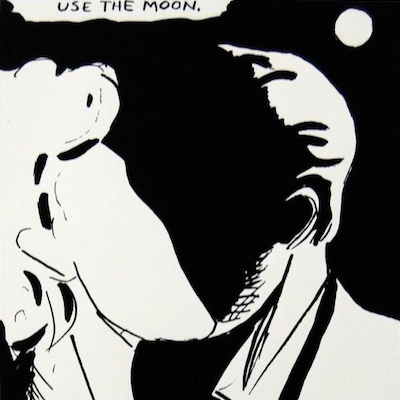
Details
Artist
Styles
Screenprint on Lanaquarelle watercolor paper - Hand-signed in pencil, dated and numbered - Catalogue raisonne Corlett 299. // Roy Lichtenstein's Composition III (1996) is a vibrant and dynamic screenprint that merges musical notation with the artist's signature comic-inspired style. The piece features sweeping, undulating staves filled with musical notes, curving across the canvas in a rhythm that mimics the flow of sound. Lichtenstein’s characteristic use of Ben-Day dots, bold primary colors, and thick black outlines brings a playful, graphic quality to the composition. The swirling lines and contrasting colors—yellows, greens, and blues—create a lively visual harmony, suggesting the movement and vibrancy of music. Printed on Lanaquarelle watercolor paper, this work is hand-signed, dated, and numbered, from an edition of 186 plus 33 special proofs. Composition III exemplifies Lichtenstein’s ability to translate the energy of music into visual form, using the visual language of pop art.
Composition III, 1996
form
Medium
Size
129 x 90.2 cm
- Inches
- Centimeters
Edition
Price
Details
Artist
Styles
Screenprint on Lanaquarelle watercolor paper - Hand-signed in pencil, dated and numbered - Catalogue raisonne Corlett 299. // Roy Lichtenstein's Composition III (1996) is a vibrant and dynamic screenprint that merges musical notation with the artist's signature comic-inspired style. The piece features sweeping, undulating staves filled with musical notes, curving across the canvas in a rhythm that mimics the flow of sound. Lichtenstein’s characteristic use of Ben-Day dots, bold primary colors, and thick black outlines brings a playful, graphic quality to the composition. The swirling lines and contrasting colors—yellows, greens, and blues—create a lively visual harmony, suggesting the movement and vibrancy of music. Printed on Lanaquarelle watercolor paper, this work is hand-signed, dated, and numbered, from an edition of 186 plus 33 special proofs. Composition III exemplifies Lichtenstein’s ability to translate the energy of music into visual form, using the visual language of pop art.
- Recently Added
- Price (low-high )
- Price (high-low )
- Year (low-high )
- Year (high-low )
Roy Lichtenstein
Before The Mirror (from Mirrors Of The Mind Portfolio), 1975
Limited Edition Print
Lithograph
USD 19,500
Roy Lichtenstein
Interior With Chair From The Leo Castelli 90th Birthday Portfolio, 1997
Limited Edition Print
Screen-print
USD 30,000 - 40,000
Roy Lichtenstein
Inaugural Print From The Inaugural Impressions Portfolio, 1977
Limited Edition Print
Screen-print
USD 25,000 - 35,000
Roy Lichtenstein
Reflections On Minerva, 1990
Limited Edition Print
Mixed Media
USD 80,000 - 100,000
Roy Lichtenstein
Pistol (from Banner, Multiples Calendar, 1968
Limited Edition Print
Screen-print
USD 4,600
Roy Lichtenstein
Apple And Lemon (from Seven Apple Woodcuts), 1983
Limited Edition Print
Woodcut
USD 14,850
Roy Lichtenstein
Red And Yellow Apple From Seven Apple Woodcuts, 1983
Limited Edition Print
Woodcut
USD 20,000 - 30,000
Roy Lichtenstein
Two Paintings: Dagwood From The Paintings Series, 1984
Limited Edition Print
Mixed Media
USD 80,000 - 100,000
Roy Lichtenstein
Reflections On Crash From Reflections Series, 1990
Limited Edition Print
Mixed Media
Inquire For Price
Roy Lichtenstein
Reflections On Expressionist Painting From The Carnegie Hall 100th Anniversary Portfolio
Limited Edition Print
Screen-print
USD 60,000 - 70,000
Roy Lichtenstein
De Denver Au Montana, Départ 27 Mai 1972 (1), 1991
Limited Edition Print
Etching And Aquatint
USD 12,500
Roy Lichtenstein
De Denver Au Montana, Départ 27 Mai 1972 (II), 1991
Limited Edition Print
Etching And Aquatint
USD 12,500
Roy Lichtenstein
Liberté, From Mémoire De La Liberté, 1991
Limited Edition Print
Serigraph
EUR 19,750
Roy Lichtenstein
Sweet Dreams, Baby!, 1965
Limited Edition Print
Screen-print
Currently Not Available
What is Comic Strip Art?
Comic strip art refers to artwork that utilizes the subject matter and commercial printing techniques found in comic strips. In the 1960s, a group of artists began creating paintings that incorporated Ben-Day dots—commonly used in comics and advertising—to produce highly graphic designs in bright colors, using traditional art media.































































